How To Do A Ventrogluteal Injection: A Complete Guide
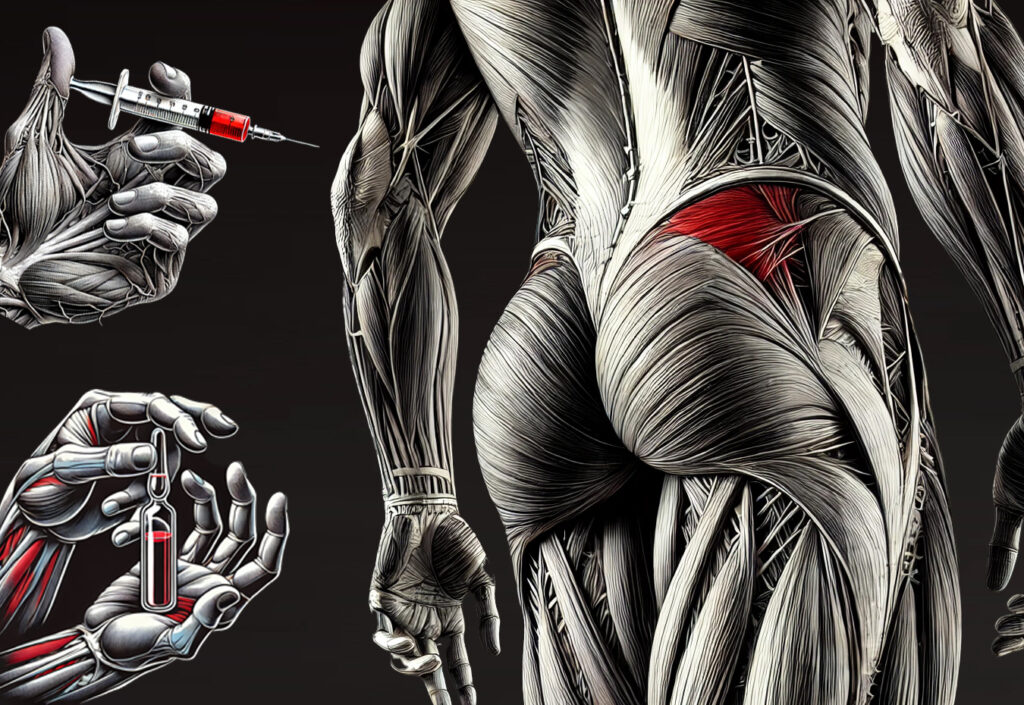
Last Updated On March 26, 2025
Mastering proper injection technique is crucial for anyone on testosterone replacement therapy (TRT) or other injectable medications. The ventrogluteal injection site has become the gold standard for intramuscular injections among medical professionals—and for good reason. This comprehensive guide will walk you through everything you need to know about ventrogluteal injections, from precise site location to step-by-step technique, ensuring safe and virtually painless administration.
What is a Ventrogluteal Injection?
A ventrogluteal injection is an intramuscular injection administered into the gluteus medius muscle, located on the side of the hip. Unlike other injection sites, the ventrogluteal area offers several distinct advantages that make it ideal for testosterone and other medication administration.
The ventrogluteal site is situated on the anterior (front) portion of the hip, specifically targeting the gluteus medius muscle. This location is accessible, well-defined by clear anatomical landmarks, and—most importantly—free from major nerves and blood vessels that could be accidentally damaged during injection.
For those on TRT, understanding and utilizing the ventrogluteal injection site properly can significantly improve comfort and reduce complications associated with regular injections.
Ventrogluteal vs. Dorsogluteal Injections: What’s the Difference?
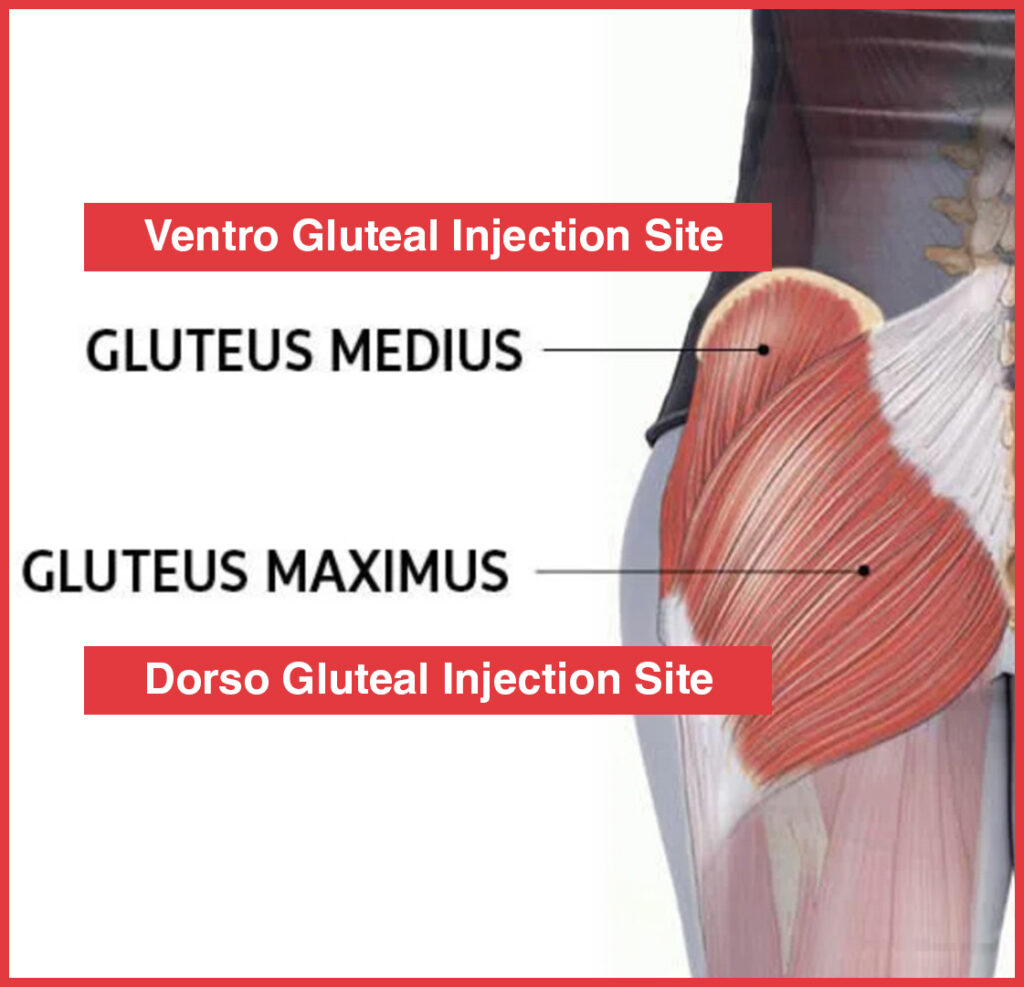
Many people confuse the ventrogluteal and dorsogluteal injection sites, but these are two distinct areas with important differences:
Anatomical Differences
- Ventrogluteal site: Located on the gluteus medius muscle at the top outer edge of the glute, near the hip and waistline
- Dorsogluteal site: Located on the gluteus maximus muscle—the central, larger part of the buttock
The ventrogluteal site targets a different muscle entirely than the traditional “buttock injection” most people are familiar with. While both are located in the gluteal region, the ventrogluteal site is more lateral (toward the side) and anterior (toward the front) of the body.
Safety Comparison
The ventrogluteal injection site has emerged as the preferred option for several crucial safety reasons:
- Reduced risk of nerve damage: The ventrogluteal area is free from major nerves (including the sciatic nerve), significantly reducing the risk of painful nerve injuries
- Fewer blood vessels: The area contains fewer large blood vessels, minimizing the chance of intravascular injection or hematoma
- Consistent muscle mass: The gluteus medius typically maintains good muscle mass regardless of patient mobility, making it reliable for effective medication absorption
- Lower pain sensitivity: Most patients report less pain with ventrogluteal injections compared to dorsogluteal ones
Healthcare professionals have increasingly recommended the ventrogluteal site over the dorsogluteal site for intramuscular injections, especially for regular administration like TRT. Research consistently shows better outcomes and fewer complications with ventrogluteal injections.
Equipment Needed for Ventrogluteal Injections
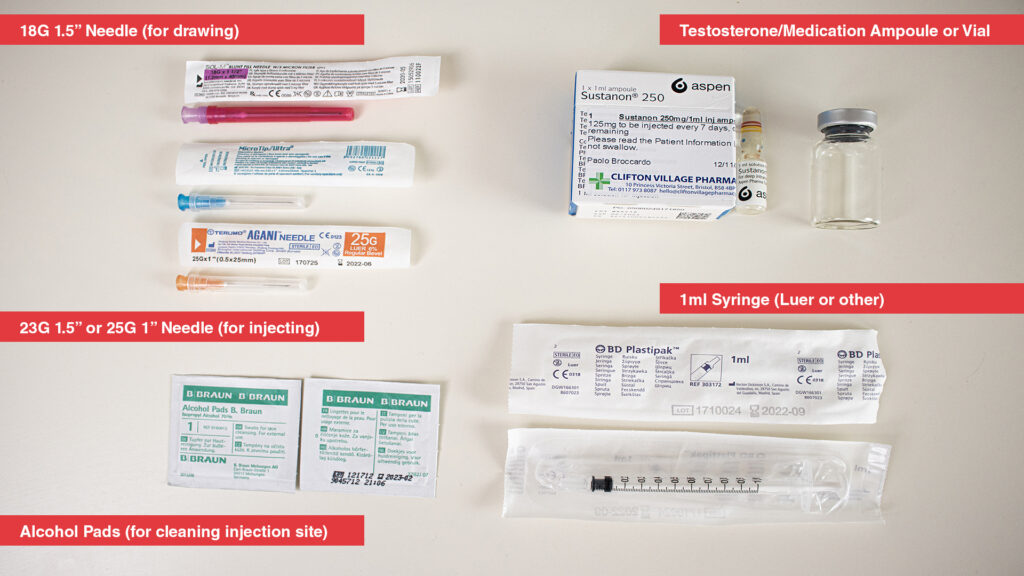
Proper equipment selection is essential for a safe, comfortable ventrogluteal injection. Here’s what you’ll need:
Essential Supplies
- Your medication (testosterone vial or ampule)
- Drawing needle (typically 18G, 1.5 inch)
- Injection needle (typically 23-25G, 1-1.5 inch)
- 1ml or 3ml syringe, depending on your dose
- Alcohol pads/swabs
- Cotton balls or gauze
- Bandage (optional)
- Sharps container for disposal
Needle Selection Guide
Choosing the right needle size is critical for ventrogluteal injections:
- Drawing needle: 18G, 1.5 inch—The larger gauge facilitates quicker and easier drawing of medication, especially for viscous solutions like oil-based testosterone
- Injection needle for lean individuals: 25G, 1 inch—Thinner needle causes less pain while still reaching the muscle in leaner people
- Injection needle for average or larger individuals: 23G, 1.5 inch—Provides adequate length to reach the muscle through subcutaneous tissue
The gauge (G) refers to the needle’s thickness—higher numbers indicate thinner needles. Length is equally important to ensure the medication reaches the muscle tissue, not just subcutaneous fat.
How to Locate the Ventrogluteal Injection Site
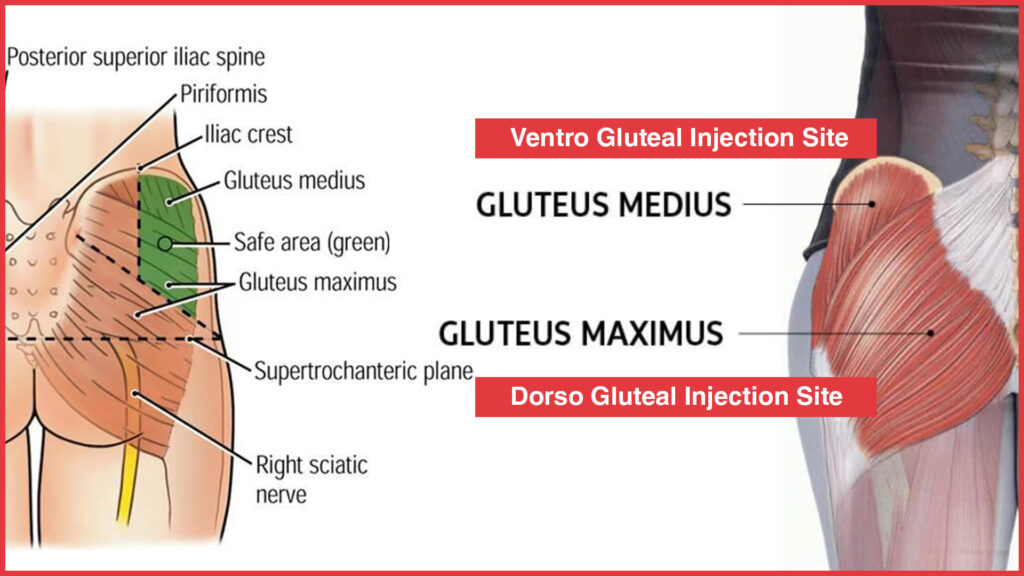
Finding the precise ventrogluteal injection site is crucial for safety and effectiveness. Follow these steps:
Using Anatomical Landmarks
- Identify the greater trochanter: This is the bony prominence at the top of the femur (thigh bone), easily felt on the side of the hip
- Locate the iliac crest: This is the top ridge of the pelvic bone, forming the “belt line”
- Form a V with your hand: Place the palm of your hand on the greater trochanter with your index finger pointing toward the anterior superior iliac spine (front point of the hip) and your middle finger extending backward along the iliac crest
- Identify the injection site: The center of the V-shape formed by your fingers is the ventrogluteal injection site
The ventrogluteal site is located high on the hip, near your waistline—not in the central part of the buttock. This is a key distinction from the dorsogluteal site.
Visual Reference Points
For self-administration, the ventrogluteal site can be found:
- At the top outer edge of your glute
- Near your beltline
- On the side of your hip rather than the back of your buttock
- Approximately 2-3 inches below the top of your hip bone
Many TRT users find it helpful to use a mirror when first learning to locate this site accurately. With practice, identifying the correct location becomes second nature.
Ventrogluteal Injection Technique: Step-by-Step Guide
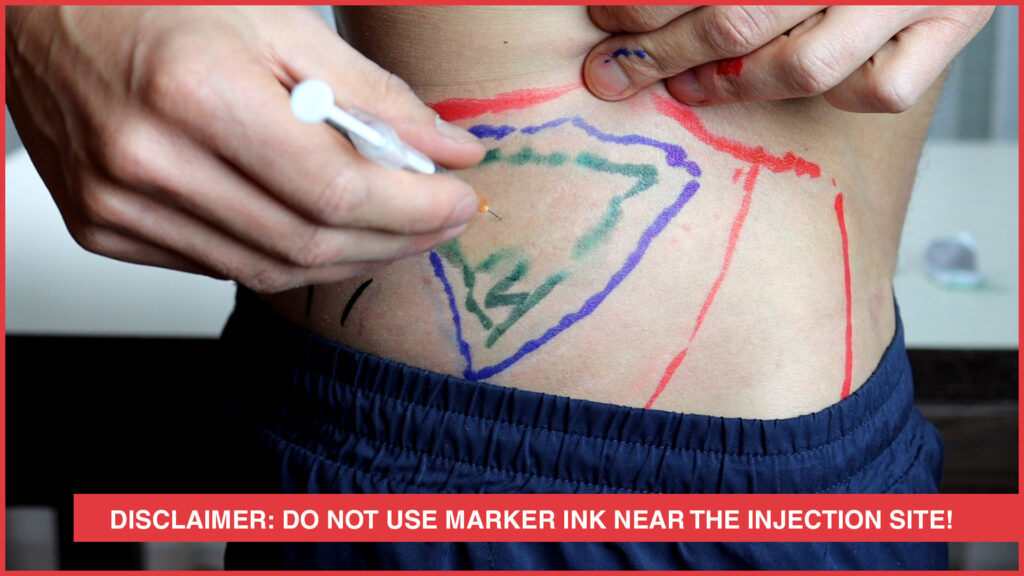
Follow these detailed steps for a safe, comfortable ventrogluteal injection:
Preparation
- Wash your hands thoroughly with soap and water
- Gather all supplies and place them on a clean surface
- Prepare your medication according to instructions (see our Injection Preparation Guide for detailed steps)
- Switch to the injection needle after drawing up the medication
Positioning
- Stand comfortably in front of a mirror if possible
- Shift your weight to the leg opposite the injection site (if injecting on the right side, put weight on your left leg)
- Rotate slightly to access the site easily
Injection Procedure
- Clean the site: Use an alcohol swab to clean the injection area with a circular motion, working outward from the center. Allow to dry completely (about 30 seconds)
- Hold the syringe: Grip it like a dart between your thumb and forefinger
- Insert the needle: In one smooth motion, insert the needle perpendicular (90-degree angle) to the skin surface
- Aspirate: Pull back slightly on the plunger to check for blood—if blood appears, withdraw the needle, replace it, and try again at a slightly different location
- Inject the medication: If no blood appears during aspiration, slowly push the plunger to inject the medication (taking approximately 5-10 seconds)
- Remove the needle: Pull the needle out at the same angle it went in
- Apply pressure: Use a cotton ball or gauze to apply gentle pressure to the site
Post-Injection Care
- Dispose of the needle immediately in a sharps container
- Apply a bandage if necessary (though ventrogluteal sites typically bleed very little)
- Massage gently around (not directly on) the injection site to help disperse the medication
- Monitor for reactions: Watch for any unusual redness, swelling, or pain
With proper technique, ventrogluteal injections should cause minimal discomfort and leave little to no bruising.
Safety Considerations and Best Practices
Pain Management
- Ensure the muscle is relaxed during injection
- Use a smooth, confident motion when inserting the needle
- Allow alcohol to dry completely before injecting to avoid stinging
- Consider using ice to numb the area before injection if you’re particularly sensitive
Infection Prevention
- Never reuse needles or syringes
- Always clean the injection site properly
- Check medication for clarity and expiration date
- Maintain a clean workspace for preparation
Site Rotation
Even though the ventrogluteal site is excellent for injections, rotation is still important:
- Alternate between left and right ventrogluteal sites
- Consider rotating between ventrogluteal, deltoid, and quadriceps sites for long-term therapy
- Keep a log of injection sites used
When to Seek Medical Help
Contact a healthcare provider if you experience:
- Persistent pain lasting more than 48 hours
- Redness, warmth, or swelling that increases rather than decreases
- Fever or chills after an injection
- Unusual discharge from the injection site
- Muscle weakness or numbness
Conclusion
The ventrogluteal injection site represents the safest and most comfortable option for intramuscular injections, particularly for ongoing treatments like TRT. By properly identifying the site, using appropriate equipment, and following the step-by-step technique outlined in this guide, you can administer injections with minimal discomfort and risk.
Remember that practice improves technique—many TRT users report that ventrogluteal injections become virtually painless once they’ve mastered the proper method. If you’re new to self-administration, consider having a healthcare professional demonstrate the technique first or watch our instructional video demonstrations.